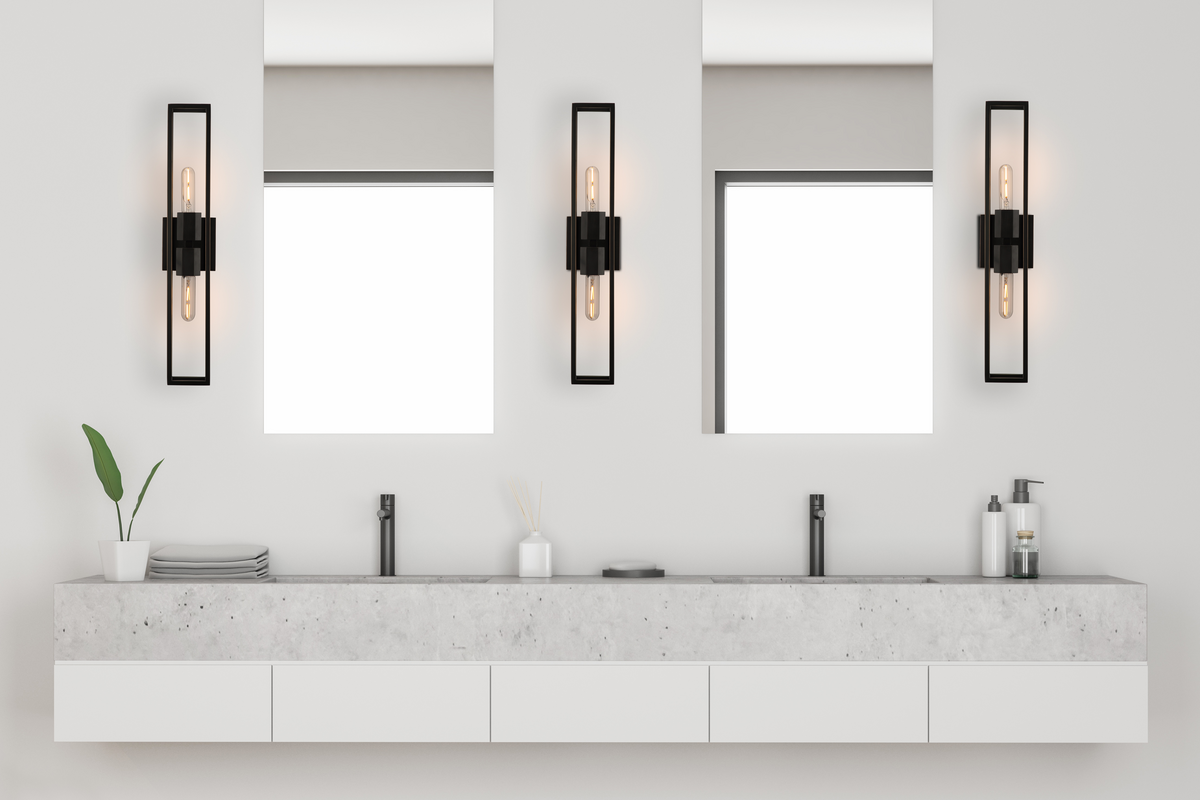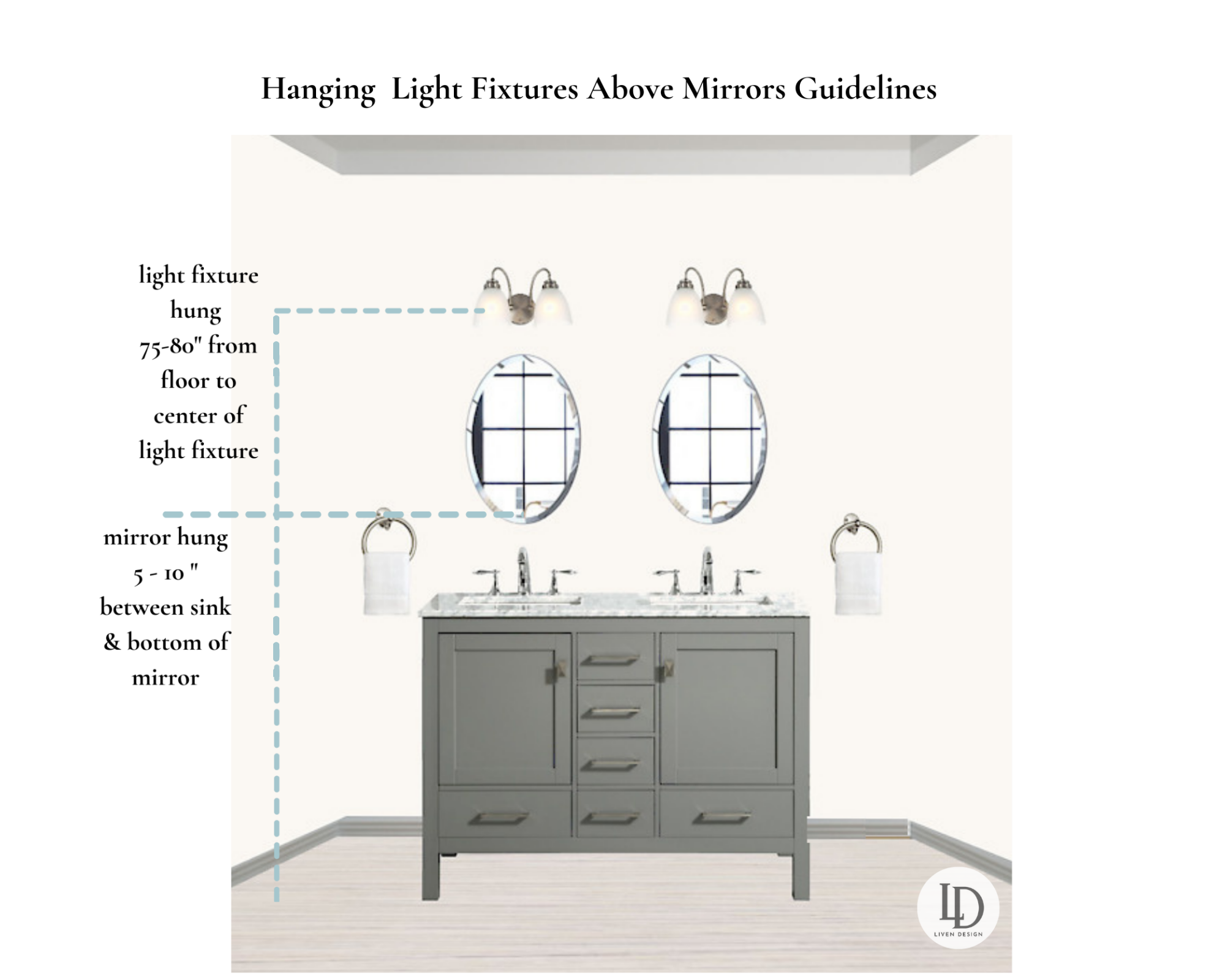Optimal Height for Bathroom Vanity Lighting

How high should a bathroom vanity light be – When determining the ideal height for bathroom vanity lights, ergonomic principles should be considered. These principles ensure that the lighting provides optimal illumination for tasks such as grooming, shaving, and applying makeup, while minimizing glare and shadows.
The distance between the vanity mirror and the light fixtures should be carefully measured. As a general guideline, the bottom of the light fixtures should be positioned approximately 30 to 45 inches above the top of the vanity mirror. This height allows for even distribution of light across the face, reducing the risk of shadows or harsh lighting.
When considering the ideal height for a bathroom vanity light, it’s crucial to consider the overall aesthetic of your space. For instance, if you’re embracing the glamour of art deco home decor , a vanity light positioned slightly higher can accentuate the vertical lines and geometric patterns characteristic of this style.
However, if your bathroom exudes a more traditional or minimalist vibe, a lower vanity light may provide ample illumination without overwhelming the space.
Ceiling Height and Vanity Size
Ceiling height and vanity size also impact the recommended height for lighting. In bathrooms with high ceilings, the light fixtures may need to be mounted higher to ensure adequate illumination. Conversely, in bathrooms with low ceilings, the light fixtures should be mounted lower to avoid overwhelming the space.
The recommended height for a bathroom vanity light is typically between 30 and 48 inches above the floor, depending on the size of the vanity and the ceiling height. However, if you’re looking for a more ambient light, you may want to consider zone 2 bathroom wall lights , which can be mounted higher up on the wall and provide a more diffused light.
Ultimately, the best height for your bathroom vanity light will depend on your personal preferences and the specific layout of your bathroom.
The size of the vanity also influences the height of the lighting. Larger vanities may require multiple light fixtures or fixtures with higher wattage to provide sufficient illumination. Smaller vanities, on the other hand, may only require a single light fixture or fixtures with lower wattage.
Types of Bathroom Vanity Lights and Their Placement: How High Should A Bathroom Vanity Light Be

Bathroom vanity lights are an essential part of any bathroom design, providing both task lighting for grooming and ambient lighting for creating a relaxing atmosphere. There are various types of bathroom vanity lights available, each with its advantages and disadvantages.
Wall-Mounted Vanity Lights
- Advantages: Wall-mounted vanity lights are easy to install and can be placed at the desired height and distance from the mirror. They provide good task lighting and can create a focal point in the bathroom.
- Disadvantages: Wall-mounted vanity lights can take up wall space and may not be suitable for small bathrooms. They can also cast shadows on the face if not placed correctly.
Recessed Vanity Lights
- Advantages: Recessed vanity lights are installed into the ceiling, providing a sleek and modern look. They create even illumination and minimize shadows on the face. Recessed lights are also less likely to collect dust and debris.
- Disadvantages: Recessed vanity lights require professional installation and may be more expensive than other types of vanity lights. They can also be difficult to adjust or replace once installed.
Pendant Vanity Lights
- Advantages: Pendant vanity lights are suspended from the ceiling and provide a decorative touch to the bathroom. They can be used to create a focal point and add a touch of style to the space. Pendant lights also provide good task lighting.
- Disadvantages: Pendant vanity lights can be difficult to install and may not be suitable for bathrooms with low ceilings. They can also swing or sway if not properly secured.
Placement of Vanity Lights
The placement of vanity lights depends on the shape and size of the vanity. For a single-sink vanity, a single vanity light can be placed directly above the mirror. For a double-sink vanity, two vanity lights can be placed evenly spaced above the mirror. The lights should be placed at a height that provides good task lighting without casting shadows on the face.
Designing a Vanity Lighting Layout

Creating a well-lit vanity area is crucial for both functionality and aesthetics. Follow these steps to design an effective vanity lighting layout:
Step 1: Assess Natural Light Sources
Determine the amount and direction of natural light in your bathroom. If your vanity is near a window, consider incorporating sheer curtains or blinds to filter harsh sunlight while still allowing natural light to illuminate the space.
Step 2: Measure Mirror Size
The size of your mirror will influence the placement of vanity lights. Measure the width of the mirror and divide it by three. This measurement will give you the ideal distance between each light fixture.
Step 3: Determine Task Lighting Needs, How high should a bathroom vanity light be
Consider the specific tasks you perform at the vanity, such as applying makeup or shaving. Identify areas that require additional illumination and plan for task lighting, such as wall-mounted sconces or adjustable under-cabinet lights.
Step 4: Choose Fixture Type
Select vanity lights that complement the style and finish of your bathroom. Consider sconces for a classic look, pendants for a modern touch, or recessed lights for a minimalist aesthetic.
Step 5: Position Lights
Place vanity lights at eye level, approximately 60-66 inches from the floor. Mount lights on either side of the mirror, ensuring they are evenly spaced and provide ample illumination.
Step 6: Consider Dimmer Switch
Installing a dimmer switch allows you to adjust the brightness of the vanity lights, creating a more versatile and comfortable lighting environment.
Step 7: Create a Cohesive Design
Coordinate the finish and style of vanity lights with other bathroom fixtures, such as faucets and towel bars. Consider the overall aesthetic and ensure the lighting complements the bathroom’s décor.